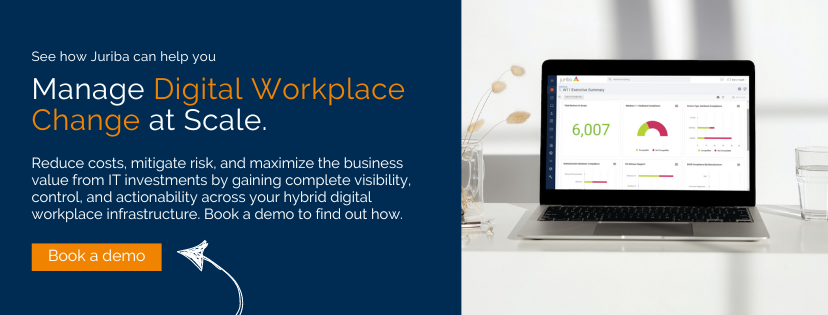Achieving sustainability goals with Device Lifecycle Management
March 22nd, 2023
7 min read
By Julia Bell

As enterprises strive to become more sustainable, Device Lifecycle Management and sustainability must be considered. With the rise of laptops and PCs in enterprise IT estates, organizations are now faced with the challenge of managing their carbon footprint while still achieving their business goals.
This blog post will discuss how Device Lifecycle Management can help companies achieve both sustainability objectives as well as cost savings by providing an overview on its impact on enterprise IT estates, best practices for effective implementation, and potential benefits associated with adopting these strategies. So join us in exploring this important topic further.
- Introduction to Device Lifecycle Management
- The Impact of Laptops and PCs on Enterprise IT Estates
- Utilizing Device Lifecycle Management to Achieve Sustainability Goals
- Best Practices for Effective Device Lifecycle Management
- Conclusion: The Benefits of Adopting Sustainable Practices in the Workplace
Introduction to Device Lifecycle Management
Device Lifecycle Management (DLM), an essential component of managing any enterprise IT estate, is defined as the process of managing laptops, PCs, and other devices throughout their entire life cycle — from acquisition to disposal. The goal of DLM is to ensure optimal productivity, cost-effectiveness, and security by keeping all devices up-to-date with the latest software patches.
It entails a range of activities related to the acquisition, deployment, upkeep, and retirement of devices. These include choosing suitable hardware models for various use cases; furnishing them with necessary applications; keeping tabs on performance metrics such as battery life or memory utilization; upgrading operating systems and security protocols; phasing out outdated machines; disposing of redundant assets in an ecologically sound way, etc. To derive maximum benefit from their IT investments over time, organizations must manage these processes adeptly.
The implementation of DLM can be a boon to any enterprise IT estate, allowing for improved employee productivity due to enhanced access to resources on optimized hardware platforms, reduced environmental footprint through the implementation of energy-saving strategies across multiple sites/locations, and increased cost savings by judiciously optimizing refresh cycles and minimizing downtime related to manual updating and patching processes.
Challenges of Device Lifecycle Management arise when there is no clear strategy or there are no policies governing how devices should be managed throughout their lifecycles. This can lead to inefficient use of resources and higher costs incurred due to delayed updates or outages caused by unsupported hardware/software configurations, which may not meet compliance requirements either. Additionally, it can also be difficult for organizations without dedicated DLM teams or toolsets in place as they lack visibility into device status and performance metrics, making it hard for them to manage large fleets efficiently and reliably over long periods of time.
Device Lifecycle Management is an essential tool for enterprises to ensure that their IT estates are efficient, secure, and compliant. As such, understanding the impact of laptops and PCs on enterprise IT estates is critical to maximizing sustainability gains while ensuring cost savings and security compliance.
The impact of laptops and PCs on enterprise IT estates
The impact of laptops and PCs on enterprise IT estates is far-reaching, with significant implications for energy consumption, cost savings, security, and compliance.
- The average carbon footprint of a single laptop, including manufacturing, shipping, and power consumption/usage over a lifespan of four years is 422.5 kg.
- The majority of its carbon footprint (75% to 85% or 331 kg of carbon dioxide [CO2]) is caused by the production and materials required to produce the motherboard, display, and disk drives.
- In addition, the manufacturing process requires more than 190,000 liters of water and 1,200 kg of sand and mud.
- According to Gartner, it is "the embodied carbon of endpoint devices that accounts for nearly half of overall IT greenhouse gas (GHG) emissions in most enterprises," "despite the common belief that data center operations and the cloud are the most significant environmental impact of IT."
Modern laptops and PCs have been designed to be more energy-efficient than ever. For instance, many models now feature low-power sleep modes that allow them to consume minimal amounts of power when not in use. Furthermore, manufacturers have also implemented the latest processor technologies which can drastically reduce overall energy usage. Organizations can now take advantage of modern IT systems while reducing their environmental impact due to recent advances in technology.
Cost savings are another key factor when considering laptop or PC investments for enterprises. By opting for higher quality machines that offer longer lifespans — as well as taking advantage of regular maintenance plans — businesses can save thousands over time by avoiding costly hardware replacements down the line. Additionally, utilizing virtualization techniques, such as containerization, allows companies to run multiple applications simultaneously without needing additional physical resources; thus reducing costs even further.
From a security standpoint, organizations must take proactive steps when investing in new laptops or PCs for their IT estates. Utilizing the latest anti-virus software is paramount in ensuring that devices are guarded against malicious attacks and data breaches. Moreover, it's essential that access controls be set up properly so as to ward off any attempts by hackers who seek to gain unauthorized entry into corporate systems through vulnerable endpoints such as employee workstations. Additionally, compliance regulations should also not be overlooked. Having policies that govern how personal information is handled on company devices will help stave off any potential repercussions down the line resulting from lax oversight today.
Overall, there is no denying that investing in new laptops and PCs for an enterprise IT estate carries its fair share of considerations. However, if done correctly, it can reap tremendous rewards both financially and environmentally. Utilizing Device Lifecycle Management to achieve sustainability goals provides an opportunity for organizations to maximize their efficiency while minimizing the environmental impacts of technology usage.
Utilizing Device Lifecycle Management to achieve sustainability goals
Device Lifecycle Management is an important tool for enterprises looking to achieve sustainability goals. Optimizing hardware refresh cycles can reduce energy consumption and carbon footprint, while also helping to save costs. Automating updates and patches can be done with ease, allowing IT personnel to guarantee that all devices are running the most current versions of their programs. Additionally, power-saving strategies, such as enabling sleep modes or adjusting screen brightness levels, can help reduce overall energy usage in the enterprise IT estate.
Organizations should devise explicit protocols and guidelines concerning Device Lifecycle Management to optimize its efficacy. This includes setting realistic timelines for hardware refreshes based on expected usage patterns and understanding how often software updates need to be deployed across different types of devices. Additionally, organizations should consider implementing automation tools like patching agents or configuration management systems which can help streamline processes related to Device Lifecycle Management.
When it comes to ensuring that power-saving strategies are being effectively utilized, companies should leverage analytics tools which provide detailed insights into how their IT estate is consuming energy at any given time. For example, these analytics tools could monitor CPU utilization rates over a period of time to determine if there are any opportunities to further optimize power-saving settings across various devices within the organization’s network infrastructure.
By utilizing DLM to accomplish sustainability objectives, organizations can not only decrease their environmental effect but also save cash over the long haul. Best practices for effective Device Lifecycle Management are essential to ensure that these objectives are met efficiently and effectively.
Best practices for effective Device Lifecycle Management
Implementing strategies, policies, and technologies to ensure cost-efficiency, security compliance, sustainability, and optimal performance of the IT estate over time is key for successful Device Lifecycle Management. To get the most out of Device Lifecycle Management initiatives in your organization, here are some best practices to consider:
Developing an end-to-end strategy
A comprehensive end-to-end strategy should be developed to guide all aspects of Device Lifecycle Management, including hardware selection and procurement, software deployment and updates, asset tracking and inventory control, and maintenance scheduling and repair services. This will help you stay on top of all activities related to devices throughout their entire lifespan while ensuring maximum efficiency and cost savings.
Leveraging automation & analytics tools
Automation tools such as scripts or bots can be used for automated deployment or patching tasks which would otherwise require manual intervention from IT personnel. Similarly, analytics tools can provide insights into usage patterns across various devices, which can then be used for better decision making when it comes to hardware upgrades or repairs.
Establishing clear policies & procedures
Having clear policies and procedures in place will ensure that employees understand how they should use their devices responsibly while also adhering to organizational guidelines regarding data privacy and security compliance standards. Additionally, having regular reviews with stakeholders involved in Device Lifecycle Management processes helps keep everyone informed about current trends and changes within the organization’s IT landscape so that decisions can be made accordingly.
By leveraging automation and analytics tools, along with establishing clear policies and procedures, organizations can ensure that their DLM strategies are effective. It is beneficial to consider the advantages of establishing sustainable practices in the workplace for enhanced staff performance and satisfaction, as well as financial savings and operational optimization.
"#DeviceLifecycleManagement is key to improving employee productivity, reducing energy costs, and minimizing security risks. #SustainabilityInTheWorkplace #SmartITEstateManagement" Click to Tweet
Conclusion: The benefits of adopting sustainable practices in the workplace
The Digital Workplace is an ever-evolving environment, and adopting sustainable practices can provide numerous benefits. Employees who are aware that their efforts contribute to the company's sustainability goals tend to be more motivated and involved. Additionally, organizations prioritizing sustainability often have lower energy costs due to increased efficiency gains, a reduced carbon footprint, and benefit from cost savings which can be reinvested into other areas of the business. Finally, by implementing clear policies and procedures for Device Lifecycle Management, enterprises can ensure compliance with relevant regulations while minimizing security risks associated with outdated hardware or software solutions.
To maximize these advantages, it is important for businesses to develop an end-to-end strategy when managing IT estates. Using a Digital Platform Conductor like Juriba, enterprises can leverage automation to reduce energy consumption, establish rules for device upgrades, decrease environmental impact, and save costs.
Julia is co-founder of Juriba where she is Chief Technology Officer. She drives the strategy & roadmap for Juriba's products. Julia is passionate about the power of workplace automation when built on the right data and platform, and has seen first hand how this can transform organizations.



